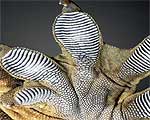For years, scientists have been trying to develop a man-made adhesive by mimicking the properties of the toe hairs of the gecko.
Earlier this year, one set of researchers, led by Ron Fearing, a University of California, Berkeley professor of electrical engineering and computer sciences, developed such an adhesive using polymer microfibres that could easily attach to and detach from clean surfaces.
But replicating the gecko's ability to walk through dirty surfaces yet keep its feet clean enough to climb walls has been tricky. In 2005, research led by Kellar Autumn, associate professor of biology at Lewis & Clark College in Portland, Oregon, revealed that a gecko keeps its feet sticky but clean by shedding dirt particles with every step.
And now, Fearing's group has created the first adhesive that can clean itself after each use. To do so, the researchers designed the adhesive with microfibres made from stiff polymers.
Using microspheres 3 to 10 micrometres in diameter to simulate contaminants, the researchers showed that the microfibres pushed the microsphere particles toward the fibre tips when the adhesive was not in contact with a surface.
When the fibers were pressed against a smooth surface, the contaminants made greater contact with the surface than with the fibres. Since adhesion strength is proportional to contact area, the microsphere particles preferentially adhered to the glass rather than to the synthetic gecko fibres.
With each simulated step, designed to provide a force similar to a gecko's step, more and more microspheres were deposited onto the surface. After 30 simulated steps, the adhesive shed about 60 per cent of the smaller-sized contaminants onto the glass surface.
'This new material likes to adhere to surfaces, but it does not like to collect dirt particles,' said Jongho Lee, UC Berkeley graduate student in mechanical engineering and one of Fearing's co-workers.

This illustration shows how a dirt particle clinging to the gecko-inspired adhesive becomes more attached to a glass surface than to the adhesive's microfibres, resulting in a dry self-cleaning effect
Larger contaminants were harder to shake off because they contact a larger number of fibres, thus adhere better to the fibres than to the glass. The researchers said that to resolve this challenge, they will need to understand more features of the gecko toe, such as whether the size of the gaps between bundles of toe hairs helps in removing dirt.
Fearing said the next phase of the research will focus on achieving adhesion over rough surfaces.




Poll: Should the UK’s railways be renationalised?
All public service companies should be nationalised for many different reasons, particularly railways, not the least because the tax payer has already...